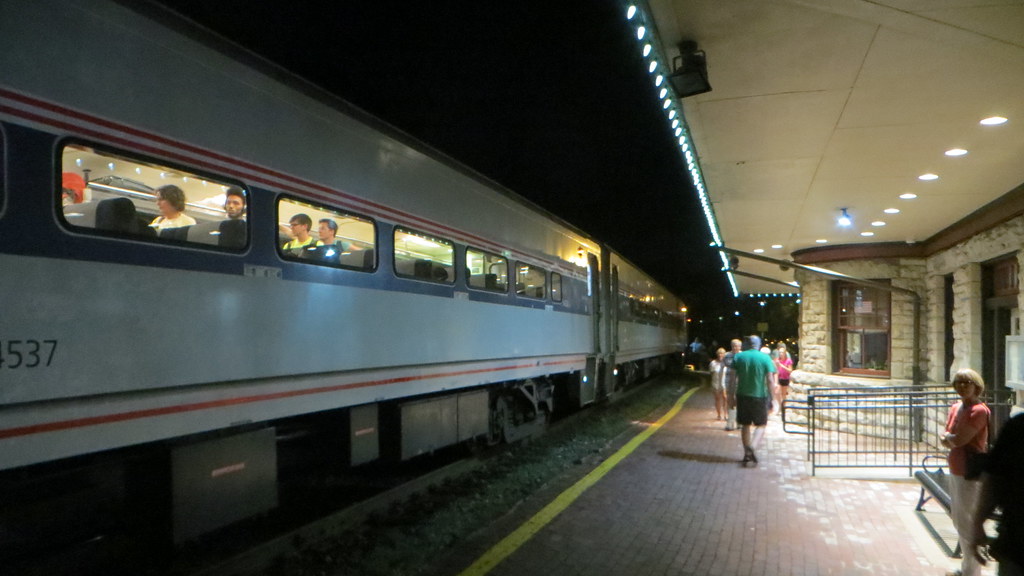
The Kirkwood train observation spot, located in Kirkwood, Missouri, is a popular destination for train enthusiasts and families. Situated near the historic Kirkwood Train Station, it offers a prime vantage point to watch various trains, including Amtrak and freight, pass through the area. The spot is known for its charming, small-town atmosphere and provides visitors with a unique glimpse into the world of railroading.
Photos
Sign in to upload photos
No Photos Yet
Be the first to share photos of this location!
Kirkwood – Kirkwood, Missouri, USA | Train Spotting Location
Trainspotting Experience
Arriving at Kirkwood, railfans usually gravitate to the public brick platform that flanks both main tracks of Union Pacific’s Jefferson City Subdivision. Trains roar past at 35–50 mph, close enough to feel the low rumble echo off the depot’s thick limestone walls. The double-track layout allows side-by-side meets; it’s common to witness a westbound manifest holding on Track 2 while an eastbound intermodal slides by on Track 1, providing uninterrupted viewing. Because the station is staffed for Amtrak, visitors can remain on the platform between passenger arrivals without trespassing issues, so long as they heed the clearly posted yellow line. Horn blasts reverberate through the small business district, and wheel flange squeals are noticeable as trains negotiate the gentle curve west of the depot. Even at night the area is well-lit by streetlamps and station lights, offering safe, round-the-clock observation.
Landscape, Setting & Local Atmosphere
Downtown Kirkwood sits on modest rolling terrain at roughly 570 ft above sea level. Mature oaks and maples fringe the tracks, especially toward the nearby Argonne Drive crossing, giving the line a verdant canopy from late spring through early fall. In winter the leafless branches open wider sight lines and highlight the stone architecture of the 1893 depot against a pale sky. Summers are warm and humid, but evening breezes funnel along the rail corridor, making dusk sessions comfortable. The neighborhood exudes a relaxed, pedestrian-friendly vibe: café patios, a weekly farmers market two blocks east, and church bells occasionally mingle with the metallic cadence of passing trains.
Type & Frequency of Train Activity
The Jefferson City Subdivision handles a balanced mix of freight and passenger traffic. Local rail observers report an average of 25–35 train movements in a 24-hour period:
• Union Pacific manifests hauling grain, ethanol, and mixed merchandise dominate daylight hours.
• Double-stack intermodals, many linking St. Louis with Kansas City, tend to run in the early morning and late evening windows.
• Unit coal and rock trains appear several times per week, length often topping 110 cars.
• Amtrak’s Missouri River Runner calls twice daily in each direction, giving spotters predictable schedules around mid-morning and late afternoon.
Typical train length ranges from 4,000 to 7,000 ft, with distributed power common on heavier westbounds climbing the gentle grade toward Eureka. Locomotive lash-ups feature GE AC4400CWs, ES44ACs, and the occasional heritage SD70ACe, while Amtrak usually fields a pair of P42DCs.
Best Angles for Photos & What Railfans Enjoy Most
- East Platform Edge – Standing near the station’s Romanesque arch, photographers can frame westbounds under the stone clock tower with late-day golden light illuminating locomotives.
- Argonne Drive Grade Crossing (¼ mile west) – A slight elevation change lets you capture long telephoto shots of trains curving into downtown, depot in the background. Morning sun favors eastbounds here.
- Pedestrian Sidewalk along South Kirkwood Road – From the public sidewalk you get nose-on angles as trains emerge beneath the highway bridge, perfect for headlight-glint compositions at sunset.
Because buildings sit close to the mains, lenses from 35 mm to 85 mm cover most needs; wider glass helps include the depot façade, while telephotos isolate power consists. Railfans praise the minimal fencing and uncluttered sight lines—no signal masts or overhead wires block the scene.
Historical or Cultural Relevance
Kirkwood Station opened in 1893 for the Missouri Pacific Railroad and remains one of only a handful of Richardsonian Romanesque depots still serving passengers nationwide. Its slate roof, arched entryways, and locally quarried limestone symbolize the town’s origin as St. Louis’s first planned suburb, laid out around rail access in the 1850s. Community volunteers saved the building from closure in the 1960s and now staff the Amtrak waiting room, reflecting a civic pride that keeps rail history alive. Annual holiday events bring vintage railcars for display, and the station’s inclusion on the National Register of Historic Places underscores its architectural importance.
What Makes This Spot Different
Unlike many suburban locations where high fences or industrial tracts isolate the right-of-way, Kirkwood offers unobstructed, street-level proximity within a lively town center. The combination of historic stone depot, double-track action, and cooperative community volunteers creates a welcoming environment for both seasoned photographers and families. Frequent meets add dynamic variety, and the ability to stay on a sanctioned platform eliminates the trespass concerns that plague many mainline hotspots.
Seasonal Information
For Kirkwood, Missouri, spring and fall offer mild weather and scenic views, ideal for train watching. Summer provides longer daylight but can be hot. Winter offers picturesque snowy scenes but may have delays. Check for special events at the historic Kirkwood Train Station.
Other Interesting Locations
Looking for more spots? Browse the complete list of train spotting locations.
Quick Information
Country
USA
Region / State / Province
Missouri
City
Kirkwood
Spot Type
Station
Best Times
Best hours to observe trains in Kirkwood, Missouri, are during weekday peak times: 7-9 AM and 5-7 PM, with additional freight activity possible in off-peak hours.
Access & Amenities
Parking
Not available
Shelter
Not available
Restrooms
Not available
